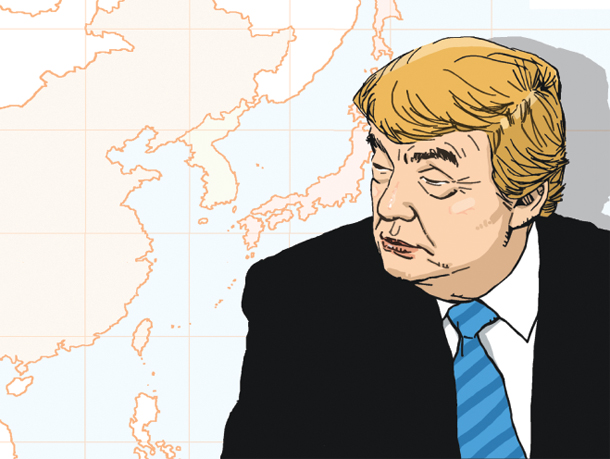The future of Trump’s Asia policy

*The author is the senior vice president for the Asia and Japan chair at the Center for Strategic and International Studies and associate professor at Georgetown University in Washington, DC.
Donald Trump is the most unpredictable and disruptive president in recent U.S. history, but his foreign policy will also be shaped and constrained by structure — the distribution of power in Asia, the rising challenges from China and North Korea, and the strong domestic support for trade and alliances in the United States, Congress and business and agricultural communities.
The importance of structure becomes most evident when viewed from a historical perspective. In my new book “By More than Providence: Grand Strategy and American Power in the Asia Pacific since 1783,” I examine the roots of U.S. policy toward Asia from the beginning of the American Republic.
One theme stands out: the United States has always pursued balance-of-power strategies to prevent threatening hegemons from turning the Pacific Ocean into a sea of danger for the American homeland. Yet while the maintenance of an open and free Pacific has deep historical roots, American strategists have also been confounded by five tensions inherent in how we influence Asia across the vast Pacific Ocean.
The first tension has been an American predilection to prioritize Europe over Asia. Even at the height of the Korean War, for example, the Pentagon was preparing five army divisions to go to Europe rather than reinforce Korea.
Things have changed, and polls show that a majority of Americans now consider Asia the most important region in the world. The Trump administration’s national security strategy also places the highest priority on Asia, but the pressures on the United States from Russia and the Middle East will continue to risk a distraction from the Far East.
The second tension has been between the maritime strategy of Alfred Thayer Mahan, which prioritizes Japan and offshore balancing, and a continental strategy favored by statesmen like Henry Kissinger that has preferred relations with China as the best anchor for American influence in Asia.
As a peninsula — both continental and maritime in nature — Korea has always been caught between these two approaches. At first, it was not clear which way Trump would lean, given his historic criticism of Japan over trade and his affinity for authoritarian leaders in the model of Xi Jinping. For now, at least, the administration has gone all in with Mahan and Japan under its “Free and Open Indo-Pacific Strategy,” but the approach still leaves uncertain the geopolitical grounding for U.S.-Korea relations in this larger context beyond the peninsula.

Historically, the United States has avoided ground commitments on the Asian continent consistent with the Mahanian maritime approach. Dean Acheson’s famous January 1950 defensive line statement, which said the U.S. defense line in Asia after China’s fall to communism would be in the waters separating Japan and the Philippines from the mainland, left South Korea exposed to North Korean aggression.
Today, Korea is far more important strategically, and Americans have learned from Acheson’s mistake, but elsewhere in Asia — in the South China Sea, for example — the question remains where American is prepared to draw the line against coercion and aggression.
The fourth tension has been over trade. The first American ship to trade with China in 1784 made a 400 percent profit on ginseng exported from Pennsylvania, and ever since, the business of America in Asia has been business.
But Americans had a high tariff until the protectionism of the 1930s led to dangerous trading blocs and war. Scarred by that lesson, the United States built an open trading regime in the postwar period that helped cement stability against communism and open new markets for American exporters.
Yet as countries like Japan, Korea and now China have grown, they have also displaced less competitive American industries. China has been particularly guilty of technology theft and non-tariff barriers. Americans have been increasingly tempted to go back to protectionism, but every president up until Trump has resisted those urges. Trump is embracing them, but he may end up harming American agricultural exports and strategic interests so much that he is pulled back by the markets or Congress.
The fifth tension has been over democracy and human rights. Americans going back to Thomas Jefferson understood that Asia was a region where empires were declining and nation-states were being born. It would therefore be inherently in U.S. interests to support free and well-governed states to counter expansionist empires.
Yet how much should the United States pressure states on how they are governed internally? Early American diplomats told the Imperial Chinese court that they stood for self-determination against the British but not that they were from a republic, lest that news frighten the Qing emperors and get in the way of trade.
Two centuries later, President Ronald Reagan was advised not to pressure South Korea to democratize too much, since we needed Korea to counter Soviet expansion. But Secretary of State George Schultz convinced Reagan that if our allies remained anti-democratic, they would also be far more vulnerable to instability, communism and Soviet suppression.
Today, Trump refuses to raise democracy with leaders like Rodrigo Duterte in the Philippines. But ultimately, the United States will find that states with greater accountability, transparency and rule of law will be better able to resist coercion from a rising China. The debate continues, with Congress pressing Trump to stand up for democratic norms more than he has thus far.
Winston Churchill was reputed to have said that Americans can be counted on to make all the wrong decisions before always arriving at the right decision. There is great flux in American foreign policy right now, but history and structure strongly suggest that the United States will step up in Asia.










with the Korea JoongAng Daily
To write comments, please log in to one of the accounts.
Standards Board Policy (0/250자)